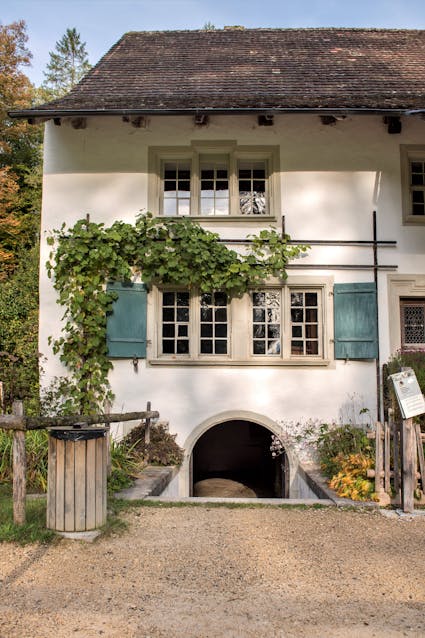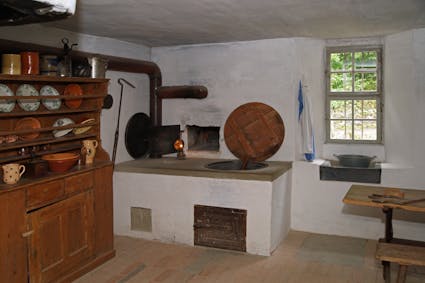131 – Farmhouse from Therwil, Basel-Country, 1675
The "Hüginhaus", named after its owner and farmer Karl Hügin who died in 1974, has been standing on the Ballenberg since 1989. A judgment of the Federal Supreme Court prevented it from being demolished.

Noblesse in a farming village
Johann Gutzwiler is recorded around 1700 as the owner. He probably had the house built. Therwil had just been devastated by war. Apparently the Gutzwiler family had succeeded in rescuing their fortune so that they could have the magnifi cent house built afterward. At that time most houses were made of wood and had thatched roofs. However, Johann Gutzwiler was able to afford to have the dwelling part of his house built in masonry with white plastered walls and with fi nely hewn stonework framing the doors and windows – this presented a noble aspect in the farming village of the time. The arrangement and embrasures of the windows were yet in gothic style, even though baroque style otherwise predominated. The size of the house and the interior appointments exceeded anything familiar to the populace of Therwil.

Living and working
The occupants lived and interacted in parlours and chambers, in cellars and kitchens behind the magnifi cent facade. There was even an outside baking oven. The working space built in stone, wood and half-timber accommodates stall, wagon shed and threshing fl oor – a separate addition houses a pig sty. The concentrated construction permitted a comfortable life and practical working under one roof.

Nearly torn down
The splendour of the foremost house in Therwil faded definitively in the boom years of 1950–1960. Some farmhouses fell to ruin, others had to make way for new buildings, yet others were “redone”, i.e. hollowed out. Often no more remained than a shell. Even this once proud house was run down. People called it the Hügin house after the last owner, farmer Karl Hügin (died 1974). It was debated whether the house should be torn down, renovated in situ or transported to the Ballenberg Open-Air Museum. The Federal Supreme Court supported transportation and since 1989 the house has been standing here. In 2013 the population of Therwil was 10,000 people, eleven of them farmers.

War profiteers?
The Thirty Year’s War devastated northern Europe between 1618 and 1648 and left many regions in ruins and ashes. Reserves were plundered, whole harvests destroyed – hunger was widespread. During this time many farmers of largely unharmed Switzerland became rich by exporting food – war profiteers, according to modern opinion.
“Pure Swissness” tour
Silk ribbon weaving – decorative ribbons made of silk
Modebewusste Frauen trugen im 19. Jahrhundert lange Kleider mit kunstvollen Bändern. Bis in die 1950er-Jahre war Mode ohne Seidenbänder unvorstellbar – Hüte, Mäntel, Röcke und selbst Haarspangen wurden mit bunten Seidenbändern verziert. Die Herstellung dieser Bänder, das Posamentieren, war seit dem 16. Jahrhundert charakteristisch für die Region Basel. Im Haus aus Therwil BL (131) wird dieses Handwerk an einem grossen Webstuhl aus dem Jahr 1895 vorgeführt.

What can you see now in Therwil where this farmhouse used to stand?
In what was once a bustling parlour, you can now get a haircut and a drink.
Ballenberg
Swiss Open-Air Museum
Museumsstrasse 100
CH-3858 Hofstetten bei Brienz
Company holidays
24 December 2025 to 11 January 2026
Opening hours Administration
3 November 2025 to 8 April 2026
From Monday to Friday
8.30 am to 11.30 am
1.30 pm to 4.30 pm
Opening hours
9 April to 1 November 2026
10 am to 5 pm daily